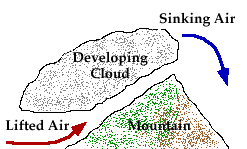|
Topography
forced lifting by the surface of the earth
Air is also lifted by the earth itself. When air encounters a
mountain range, for example, air is forced to rise up and over the mountains
and if enough lifting occurs,
water vapor condenses
to produce orographic clouds.

In the United States, the prevailing winds are generally
from west to east, so most
orographic clouds form on the western side of a mountain.
Why do orographic clouds appear to be stationary?
Air rises on a mountain's windward (upwind) side and
sinks on the lee (downwind) side.
This sinking motion warms the air and causes the
cloud to
evaporate,
destroying the cloud. Therefore, even
though the wind blows over the mountain,
condensation processes and associated
cloud droplets are confined to the windward side.
This is why orographic clouds
begin on the windward side
of the mountain and end near the summit.
[Image: orographic cloud (78K)]
Photograph by:
Holle
The Rocky and the Sierra-Nevada Mountains are examples of mountain ranges
that produce orographic clouds.
The large dark cloud in the upper right-hand corner of the picture above and
the smaller cloud just above the mountain are both
examples of orographic clouds.

fronts
|
|

transport
|
|


